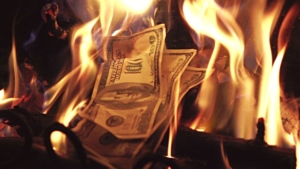
Within the next six to twelve months, the Tesla Shorts will be insolvent.
On the eve of Tesla’s transformation from high-end niche player to unstoppable mass-market powerhouse, $TSLA is the most-shorted stock on Wall Street. For those unfamiliar, shorting means you bet that a stock will go down. The way it works is you borrow shares you don’t own from person A, pay interest on the shares to person A, sell the borrowed shares to person B, then hope to purchase the shares later at a lower price to return the shares to person A. If the stock goes down a lot, you make a lot of money.
The problem with shorting a stock is if you’re wrong, and the stock goes up, your losses could be unlimited. When you buy a stock in the belief it will go up in the future, which is known as a long position, all you risk is your initial investment. But because a short-seller is forced to repurchase the stock later, his potential loss is equivalent to how much the stock rises – and stocks can go up an unlimited amount. Clean Technica explains it in further detail here.
As we previously explored, Tesla will demonstrate with its Q3 or Q4 2018 results that building and selling Model 3 is profitable. When that happens, the stock goes up a ton. What we have here is a setup for an unprecedented short-seller meltdown.
When a stock is heavily shorted, and it goes up a lot, what happens is known as a short squeeze: all the shorts desperately try to bail out of their short positions and buy shares to return to the lenders. But, because the longs aren’t selling while the stock runs up, there aren’t enough shares available for the shorts to cover. This forces the stock up even more, exacerbating the shorts’ losses.
The Mother of All Short Squeezes is coming.
Take for example Mark Spiegel, proprietor of postage-stamp-sized hedge fund Stanphyl Capital (assets under management: $8.5 million). I have no idea what ‘Stanphyl’ stands for, perhaps ‘Short Tesla, Anxiously Nervous, Praying Heartily Ya’ll Lose,’ or something. He’s been short TSLA since the stock was in the 90s. When the stock jumped in response to the company massively ramping production and revenues, and eventually delivering the highest-rated car in Consumer Reports history, Spiegel apparently decided this was a sign to double down, and increased his short position. His average basis price is 251. At TSLA’s current price of $290, Spiegel’s bet against TSLA is down 15%. Given that his TSLA short is reportedly 25% of his portfolio, he’s down over $350,000.
He could, if he wanted to, cut his losses, buy the shares back for $290 to repay the lenders, and get out of his losing game.
But, no. Spiegel is certain the sky is about to fall. He says his plan is to cover (buy the shares back) “somewhere between the 30s and zero.” At 30, he’d make 830% on his investment. And Elon Musk would, after all, have to mainline shots of Teslaquila, dried tracks of tears and all.
But. When Tesla produces Model 3 profits, and the stock hits 400 and keeps climbing, what will Spiegel do? At $400, his loss is 59%. At 500, his loss is 99%. At $600, which TSLA will hit within the next three years, his loss will be 179%! Meaning, if he originally invested $2.5 million in his short position, he loses it all plus an additional $2 million. When TSLA hits 1,000, which it will eventually, his hedge fund is a zero. Adios, Stanphyl. You were almost a Berkshire Hathaway.
It’s amazing how disturbed human psychology reliably engages in projection, which in layman’s terms, means “seeing in others a perceived flaw that is entirely about you and your own, disowned, unconscious flaws.”
Mark Spiegel’s catchphrases are, “Tesla is a zero,” “Tesla is going bankrupt,” and “Tesla has created nothing of value.” Hold a mirror up, Mark. You just described your hedge fund.
Mark and his merry band of bears at Seeking Alpha can be persuasive. They point out that Tesla has allegedly ‘incinerated billions of dollars,’ as if the company is shoveling money into a furnace. What they don’t say is that Tesla has invested billions of dollars in building valuable assets such as the Gigafactory, the Supercharger network, manufacturing infrastructure, autopilot software, Model 3 – the iPhone of cars, and many other assets.
They also point out that Tesla has been unprofitable for most of its existence. What they don’t say is Amazon was unprofitable for decades, plowing revenue right back into growth. Anyone who doesn’t know any better, reading the FUD-storms that the shorts generate every now and then, would be convinced that the sky is about to fall.
History doesn’t repeat, but it rhymes. Tesla’s stock has gone up 17.5X since its IPO in 2010 at $17 per share, wiping numerous shorts out in the intervening eight years. Whitney Tilson, managing partner of Kase Capital Management, shut down his fund after his short position lost tens of millions of dollars while the stock shot from $35 to $205 between 2013 and 2014. “It was the worst short I’ve ever had… a traumatic experience,” Tilson said.
Tesla shorts lost a combined total of $2.74 billion in 2017. That’s an appetizer compared to what’s coming later this year. Shorts have bet a staggering $10 billion that Tesla won’t make the Model 3 profitably.
Angel Investor Jason Calacanis sums it up: “Anybody who bets against Elon Musk is betting against the future of humanity… These idiots who short Tesla stock are jumping in front of a Maglev train.”
Calacanis couldn’t possibly be more wrong.
These idiots are jumping in front of a Tesla Semi.
CEO Elon Musk had this to say just before this story went live:
Oh and uh short burn of the century comin soon. Flamethrowers should arrive just in time.
— Elon Musk (@elonmusk) May 4, 2018